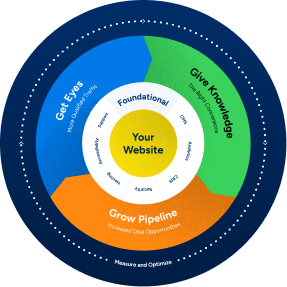Your website is the digital equivalent of a brick-and-mortar office space on the Internet, and the various landing pages you create to highlight your products and services could be considered meeting spaces where you entertain clients and hold sales meetings. A well-designed website will keep visitors on your page long enough to complete the buyer’s journey and navigate further into the infrastructure of your page and your organization’s sales funnel. On the other end of the spectrum, a poorly designed landing page and website will cause a visitor to navigate away from your page prematurely. Known as a bounce rate, this metric is one of the most important and yet difficult to manage when designing a webpage and incorporating effective SEO measures.
Ready to hire a professional marketing team?
GoingClear understands how important minimizing bounce rate is, especially for small businesses operating in the highly competitive Boston economic landscape. When it comes to responsive web design packages, we strive to ensure our clients’ websites accomplish the ultimate goal of driving business and increasing revenue. In this blog, we’re going to explore what constitutes a bounce rate, and how to create a world-class experience on your website in order to minimize that metric.
Bounce Rates As They Relate to Websites
At the top end, a bounce occurs when a site visitor leaves your website after viewing the page upon which they landed without navigating further within the infrastructure of your website. Thus, the percentage of people who do not interact with your site beyond the landing page equals your bounce rate.
Single-Page Bounce Rate
Landing pages are often designed for specific purposes, so it’s important and useful to track how effectively that page is converting visitors to specific links or behaviors on your website. So knowing the bounce rate of a single page lets you track whether a page needs to be redesigned or if it’s meeting the needs of visitors and the marketing team.
Site-Wide Bounce Rate
You can calculate the bounce rate of all landing points across your website, and then divide the bounces by the total number of site visits, providing an average bounce rate across your whole website in a given period of time.
Is Your Bounce Rate Good? It Depends.
A number of factors determine what is considered an effective bounce rate, such as industry, page intent, target demographics, country of origin, and the method or device being used to access the site. All of those factors considered, values of a “good bounce rate” can range anywhere between 26%-70%. Consider taking a deep dive into bounce rates appropriate for the site you’ve built and your own marketing goals, set a baseline, and then track performance from that point. Once you’ve done this, you can start exploring what might be impacting your bounce rate.
Why Aren’t Your Visitors Sticking Around?
Just as there are a number of factors that determine an effective website’’s bounce rate, similar factors can actually cause your bounce rate to increase and negatively impact the effectiveness of your website. Assessing and addressing each in turn can over time improve the performance of your website.
Google Analytics Can Help You Capitalize On Page Traffic Patterns In Order to Improve or Modify Content
The analytic tools provided by Google Analytics are such that you can drill down into the behavior and actions of every visitor to your website – time spent on the page, what they click, and their actions from there. These behaviors can be aggregated and segmented in order to understand who is visiting your site and how they are doing so. You might find certain demographics aren’t engaging as you’d like them, or that traffic sourced from mobile devices might be bouncing more often than desktop users. These insights can provide crucial information that will help identify other issues that might be impacting user experience and leading to bounce rate increases.
Improve the User Interface and Rearrange Content
If visitors find your website difficult to navigate, they will not waste time trying to figure it out. In order to maintain their attention and to keep them on your site, your navigation menus and page layout should guide them from page to page. Links should be easy to identify, and they should easily determine where they are within the hierarchy of your site. The layout should feature the content and calls to action in such a way that they’re the focus of the page. Content not important to the landing page’s purpose or call to action should be removed from the page.
Optimize Your Site for Mobile Responsiveness and Loading Speed
A page built for a desktop screen will not display properly on mobile devices. Modern website design standards generally call for websites to be built to adapt to the device upon which they are being viewed. Coding methods rearrange and restructure the site depending on the screen size, and will actively adapt when resized. This will protect and improve the visitor experience regardless if they are viewing on a mobile device or on a personal computer.
Similarly at the design phase, it’s important for visual elements and layout elements to be optimized in such a way that site loading speed is maximized. Viewers tend to bail on pages that take longer than 2 seconds to load, so ensuring your website can achieve this metric is one of the most important things you can do to reduce bounce.
Direct Internal and External Links to New Tabs
While internal linking and external links are vital to SEO performance for your website, one of the most damaging things you can do in regards to bounce rate is to have links open in the current navigation tab. Either they will be taken away from your landing page and fail to convert, or be transferred off of your website altogether. Either way, the page earns a bounce. Instead, your site should be coded to open linked content in a new tab. They will still technically be on your page, and more likely to return to the landing page and continue onward to your call-to-action.
Feature Relevant Content with Powerful Calls to Action
The most important thing you can do to reduce bounce rates is to provide visitors with content that is meaningful to them and inspires them to click through any calls to action that might be on the page. If they reach your page expecting fresh, relevant content and instead find outdated content that isn’t useful or relevant to why they chose to visit your page, not only will they bounce off of your page, but they will be less likely to return.
Boston Businesses Need Solid Website Design Packages to Effectively Improve Their Bounce Rates
An effective website is one of the most powerful business tools a company can deploy in order to drive sales and improve bottom line profitability in the current economic landscape. A website that does all of the heavy lifting for your sales and marketing department is one that can attract readers and keep their attention long enough to convert them into paying customers. If you’re a Massachusetts-based small business owner struggling to reduce your bounce rate, contact GoingClear’s team of website design specialists today to learn how to improve your site and increase profitable website traffic.

